The term “diamond crown angle” typically refers to the angle at which the crown of a diamond (the upper portion above the girdle) is cut. This is an important aspect of a diamond’s cut quality, as it influences the diamond’s brilliance and sparkle.
Key Points about the Diamond Crown Angle:
Crown:
The crown of a diamond is the top part of the diamond, extending from the girdle (the widest part of the diamond) to the table (the flat top surface).
The crown angle, or crown facet angle, is the angle formed between the plane of the table and the crown facets (the facets that make up the crown).
Crown Angle and Brilliance:
The crown angle plays a crucial role in how well a diamond reflects light. The angle affects how light enters and exits the diamond, impacting its brilliance (the white light reflected from the diamond) and fire (the dispersion of light into different colours).
A well-proportioned crown angle helps the diamond reflect light optimally, creating maximum brilliance and sparkle.
If the angle is too steep, the diamond can appear dark and lack brilliance, as light is directed away from the stone. Conversely, if the angle is too shallow, the diamond may lack depth and the light can escape through the bottom.
Ideal Crown Angle:
For a round brilliant diamond, the ideal crown angle typically ranges from 34° to 35°. Diamonds within this range tend to exhibit optimal brilliance and fire.
However, the crown angle must be considered in combination with other factors like the pavilion angle (the angle of the lower portion of the diamond) to achieve ideal proportions and light performance.
Ideal proportions typically result in a diamond that performs well in terms of both brilliance and fire, creating a visually pleasing sparkle.
Diamonds with Different Crown Angles:
Steep Crown Angle: A crown angle greater than 35° can lead to a steep crown, which might cause the diamond to appear darker or less sparkly due to light leakage.
Shallow Crown Angle: A crown angle lower than 34° can result in a shallow crown, which can make the diamond appear flat and may cause light to escape out of the sides of the stone, diminishing its brilliance.
Measuring the Crown Angle:
The crown angle can be measured using specialized tools and instruments in a gemological laboratory. It is often included in a diamond’s grading report (such as those provided by the GIA or DCLA), where the diamond’s cut quality is assessed.
Cut Proportions and Overall Performance:
The crown angle is part of the overall cut grade, which also considers other factors like table size, pavilion depth, and girdle thickness. These factors work together to determine the diamond’s overall brilliance and visual appeal.
A diamond with an excellent cut will have a crown angle that complements the pavilion angle, creating a balanced and well-proportioned stone that maximizes light performance.
How the Crown Angle Affects Diamond Quality:
A diamond’s cut quality is considered the most important factor in determining its overall appearance, often more important than its carat weight, colour, or clarity. A diamond with an optimal crown angle is more likely to have exceptional light performance, ensuring the diamond sparkles brilliantly.
In diamond grading reports, such as those from the DCLA (Diamond Certification Laboratory of Australia) or GIA (Gemological Institute of America), the crown angle is used to evaluate the diamond’s cut quality and assess how well it will reflect light.
Summary of Ideal Crown Angle:
Round Brilliant Cut: Ideal crown angle is typically between 34° and 35° for maximum brilliance.
The crown angle works in conjunction with other factors, like the pavilion angle, to influence the diamond’s overall light performance.
If you’re considering purchasing a diamond, the crown angle is a crucial factor to keep in mind when evaluating the overall cut quality, as it directly affects how much sparkle and brilliance the diamond will exhibit.

